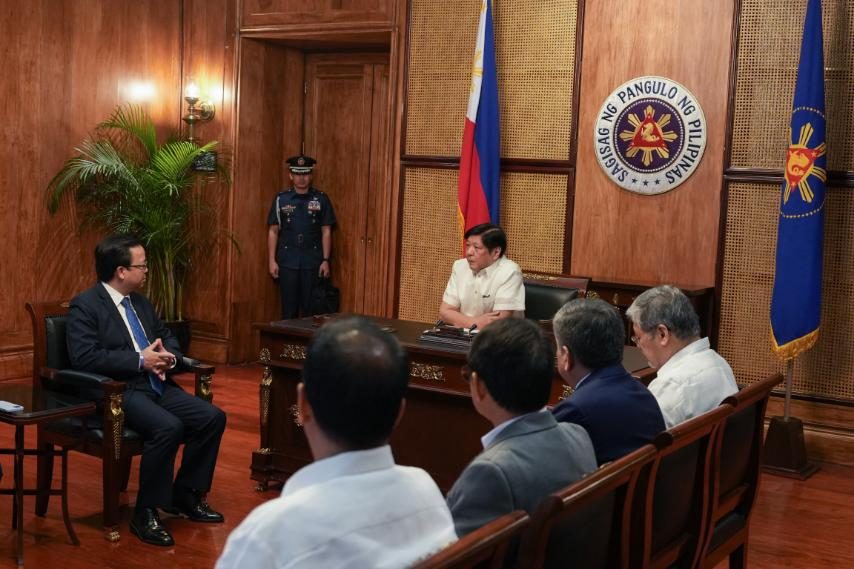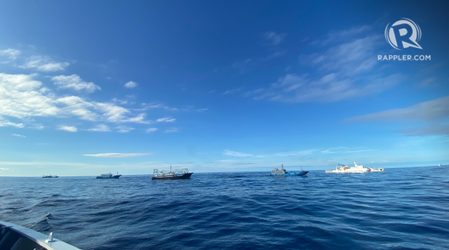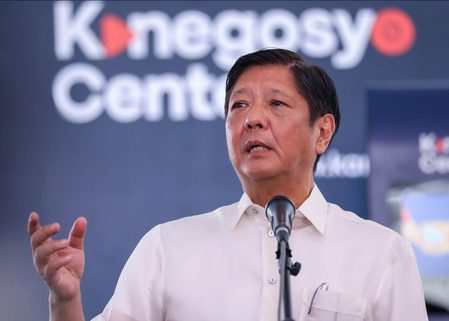SUMMARY
This is AI generated summarization, which may have errors. For context, always refer to the full article.

After back-to-back water cannon incidents in the West Philippine Sea and calls for Manila to reject Beijing’s top envoy here, President Ferdinand Marcos Jr. appears to be taking a step back, saying it’s important “to be very careful that we do not overreact” when it comes to what he calls the “most complex geopolitical challenge that the world faces.”

Speaking to Philippine media in Tokyo on December 18, Marcos said that while the Philippines is “exerting all efforts” as China increases its presence in Ayungin Shoal, it also needs to make a calibrated response.
“We have to be very careful that we do not overreact, that we do not make mistakes that might be misinterpreted by anyone. Kailangan talaga maingat tayo dahil ‘pag may nangyari ulit diyan (We need to be careful because if something happens there), if we heightened the tensions, it won’t lead us to a good result,” he said.

But tensions Marcos is referring to have already been rising, particularly in the latter months of 2023. Ayungin Shoal, located just over 100 nautical miles off the coast of Palawan, is a feature within the Philippines’ exclusive economic zone that’s also claimed by China as its own.
The BRP Sierra Madre, a World War II-era warship manned by a handful of sleety Marines, serves as the Philippines’ rusty but resilient outpost in the shoal. But as time and the elements wear it down, resupply missions have become even more important to bring both basic supplies and repair materials on board.
Those missions – called routine rotation and resupply (RORE) missions – are fraught with danger, as China Coast Guard and Chinese Maritime Militia ships try to block Philippine Coast Guard and military-contracted boats that try to make it to the BRP Sierra Madre.
The Philippines does not deploy gray or military ships to RORE missions in Ayungin, mostly in a bid to manage tensions in the area.
Yet confrontations have certainly escalated. Following December 9 and 10 water-cannon incidents in Bajo de Masinloc and Ayungin Shoal, Marcos tagged the Chinese Coast Guard and Chinese Maritime Militia actions as “aggression and provocations.”
In an interview with Japanese media, Marcos said a “more assertive China” was a challenge to the region. “I’m afraid we’ll have to be able to say that tensions have increased rather than diminished for the past months or the past years and that’s why we have to – but we continue to counsel peace and continue communication between the different countries – everyone that is involved,” said Marcos.
In response to that Marcos interview, Chinese Ministry of Foreign Affairs spokesperson Wang Wenbin said in a press conference on December 18 that it’s “the Philippines who is breaching the common understandings with China and heightening tensions in the South China Sea.”
Wang also repeated China’s previous claims – including that the Philippines has promised to tow the BRP Sierra Madre from Ayungin. Marcos himself has said that no such promise exists.
“The Philippines, bolstered by external support, has brushed aside China’s goodwill and restraint and repeatedly challenged China’s principles and red line. This is the major risk that could drive up tensions at sea,” said Wang.
China has been pinning the blame both on Manila and its allies – the United States, especially – for tensions in the West Philippine Sea, or part of the South China Sea within the Philippines’ EEZ.
Ties with Beijing
Marcos also shut down talk that Manila should send back Chinese Ambassador Huang Xilian, amid reports that China’s top envoy “bullied” the Philippines’ military chief. A handful of Philippine legislators – including Marcos’ allies – have said that Huang should be sent back to China.
“He’s the Ambassador of China. So, he will always take the Chinese position. Again, kung siguro ako ang personally ang pinag-uusapan (Maybe if we talk about myself), maybe I’ll be upset. But you’re not talking about me, we’re talking about the Philippines. So, it doesn’t serve any purpose for us to lose our temper or to overreact,” said Marcos.
The Department of Foreign Affairs (DFA) earlier said that the recall of an ambassador – or in Huang’s case, asking China to recall their envoy – is a serious action and should be “seriously considered” before acted on.
At the same time, DFA spokesperson Teresita Daza, herself a former ambassador, reminded Huang of his role as a bridge-builder.
“I would also like to add this: an ambassador is supposed to build bridges, and not strain relations. We are calling that… he actually assumes… that he will try to do his best to actually enhance relations between the two countries, just as we expect our ambassadors abroad to do the same,” said Daza.
Again speaking to Japanese media, Marcos himself has admitted that diplomatic efforts with China showed “very little progress” and were heading “in a poor direction.” Without elaborating, he said a “paradigm shift” was needed in handling the West Philippine Sea.
Sources have indicated that Marcos’ last bilateral meeting with Chinese President Xi Jinping on the sidelines of a summit in San Francisco was not promising at all. Days after that meeting, the Philippines embarked on separate joint air and sea patrols with the United States, and then with Australia.
Security and defense officials, again without elaborating, earlier said they were proposing a new strategy for the risky resupply missions to Ayungin. – Rappler.com
Add a comment
How does this make you feel?


![[Rappler’s Best] Fasten seatbelt, Mr. President](https://www.rappler.com/tachyon/2024/07/fasten-seatbelt-mr-president-edit.jpg?resize=257%2C257&crop=235px%2C0px%2C720px%2C720px)

![[OPINION] Power of mimicry: How human rights are covertly undermined in PH](https://www.rappler.com/tachyon/2024/06/duterte-marcos-human-rights.jpg?resize=257%2C257&crop_strategy=attention)
![[Vantage Point] BBM Year 2: Hits and misses](https://www.rappler.com/tachyon/2024/06/thought-leaders-marcos-hits-and-misses.jpg?resize=257%2C257&crop=277px%2C0px%2C720px%2C720px)


![[ANALYSIS] High noon for Marcos](https://www.rappler.com/tachyon/2024/06/high-noon-for-marcos.jpg?resize=257%2C257&crop_strategy=attention)




![[ANALYSIS] The West Philippine Sea dispute and the stock market’s performance](https://www.rappler.com/tachyon/2024/06/thought-leaders-west-ph-sea-dispute-and-market-performance.jpg?resize=257%2C257&crop=134px%2C0px%2C720px%2C720px)

There are no comments yet. Add your comment to start the conversation.